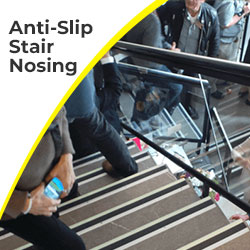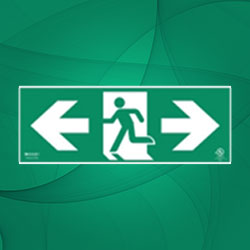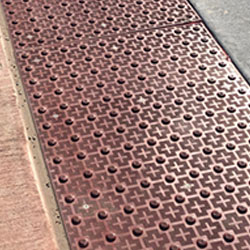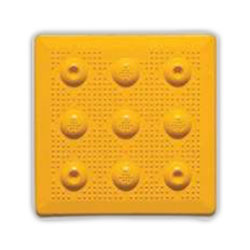
















































































































Proper installation is crucial for tactile indicators like detectable warning surfaces to maximize accessibility, safety, and longevity. Even minor errors in tactile marker placement or tile application can severely undermine functionality.
As Canada's leading supplier of accessible building products, we at Tactile Solution Canada want to highlight common installation missteps with tactile walking surface indicators and how to avoid them. Adhering to specifications and using certified installers prevents defects that render tactile systems ineffective.
Tactile walking surface indicators (TWSIs) refer to textured ground surfaces that convey vital accessibility information through touch. Two main types exist:
Warning Tactile Indicators: Textures with truncated tactile domes that alert users to hazards like platforms, stairs, vehicle routes, etc.
Wayfinding Tactile Indicators: Textures with parallel raised bars that direct users along appropriate pedestrian circulation paths.
Proper installation ensures these tactile cues are positioned correctly and securely fastened. Let's examine installation pitfalls to avoid.
Tactile indicators must be placed accurately to serve their function correctly. For warning indicators, improper placement jeopardizes hazard notification. With wayfinding indicators, imperfect placement misdirects users.
Solutions:
Consult design drawings to verify specified tactile locations.
For standardized placements like platform edges, refer to codes like CSA B651.
Seek guidance from accessibility specialists on appropriate positioning.
Insufficient tactile marker coverage leaves key areas devoid of accessibility cues.
Solutions:
Review minimum surface area standards for each application in CSA B651.
Based on regulations, ensure tactile pads extend fully across walkways, ramps, and platform edges.
Confirm sufficient visual contrast between tactile and surrounding surfaces.
The orientation of tactile markers impacts detectability. For example, wayfinding bars must align with circulation routes.
Solutions:
Double-check design plans for tactile orientation relative to pedestrian movements.
Arrange wayfinding bar tiles perpendicular to the direction of travel.
Consult with CNIB representatives on appropriate orientation.
Dimensional defects like insufficient dome spacing, diameter, and height reduce tactile detectability.
Solutions:
Verify all dimensions, including truncated dome size, height, and spacing, adhere to CSA B651 specifications during installation.
Use calibrated measuring tools to check dimensions regularly.
Review product Data Sheets to confirm tactile system compliance.
Improperly seated tactile tile edges pose tripping risks and impair wheeling.
Solutions:
Select tiles with beveled borders to provide smooth transitions.
Ensure surface-mounted tactile tile edges get trimmed flush with surrounding floors.
Confirm proper subfloor preparation and use of setting compounds for even surfaces.
Poor bonding leads to loose tiles that detach, causing safety issues.
Solutions:
Strictly follow the adhesive manufacturer's instructions for setting tactile tiles.
Check bond strength at intervals during the curing period.
Consider more robust mechanical anchors instead of adhesives alone in specific settings.
Insufficient visual contrast diminishes safety for low-vision users.
Solutions:
Opt for brightly colored tactile tiles like safety yellow where possible.
Ensure noticeably different lightness/hue between tactile tiles and ground plane.
Border tactile pads with high-contrast tactile strips for added detectability.
Certain tactile materials lack exterior durability or slip resistance.
Solutions:
Consult standards like CSA B651 to select suitable materials for each application.
Verify product testing data to confirm weathering performance, lifespans, and slip ratings.
Privilege sturdy metals, polymers, porcelain, and granite over low-cost materials.
Failing to assess current surfaces leads to improper preparation and faulty application.
Solutions:
Survey existing substrates for soundness, flatness, drainage, and fastening options.
Specify appropriate setting compounds and adhesives based on conditions.
Correct deficiencies like cracks, sloping, and pooling water before installing tactile.
Poor visibility complicates tactile location, especially for low-vision users.
Solutions:
Advise design teams to provide sufficient overhead lighting near tactile installations.
Use photoluminescent tactile products to add glow-in-dark visibility.
Test illuminance levels post-installation for hotspots, shadows, and glare issues.
By being vigilant of these common installation missteps, stakeholders can take corrective actions to implement compliant, durable, and effective tactile systems.
We provide comprehensive installation instruction guides for all tactile products to promote proper application. Referring to manufacturer guidelines and involving certified installers mitigates defects in the tactile application.
Attention to specifications, certified installers, quality control, and guidance from tactile specialists help avoid preventable errors that compromise accessibility. Adhering to standards like CSA B651 ensures tactile systems fulfill their vital function of promoting universal mobility and safety. Contact our team at Tactile Solution Canada to learn more about installation services.
Here are some common installation-related queries:
Inspections at project completion or annually using standards like CSA B651 cover placement, dimensions, materials, contrast, adhesion, and transitions.
Installers should be certified by manufacturers or have 5+ years of installing similar systems. Tactile providers offer training.
Guidelines should be reviewed thoroughly before installation and periodically referenced during application.
Properly installed and maintained outdoor tactile systems last 10-15 years. Indoor applications last 15-25+ years before requiring replacement.
Protect installed tactile from traffic using boards/mats. Schedule tactile application as one of the final steps before turnover.
